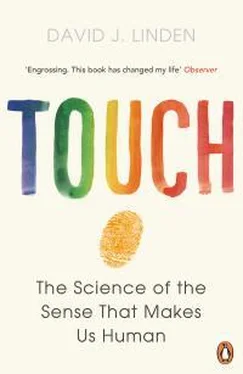5. Attenuation of self-generated touch is just one example of a more general phenomenon in the brain to reduce or ignore the sensory consequences of self-generated motion. When we move our vocal cords to speak, this temporarily reduces our ability to perceive sound, particularly other voices: It’s difficult to speak and listen at the same time. In the visual system there’s an even more dramatic example. Your eyes continually dart about using tiny fast motions called saccades. If we yanked a video camera around to mimic the way your eyes move and then played the resultant movie on a screen, the jerky image would be very difficult to watch and interpret. Instead, your brain has a circuit that totally blanks out your conscious perception of the stream of visual information during these saccades and fuses together the more stable parts of the visual information stream to create a useful visual scene that appears seamless and coherent. Movement in the visual world that results from rapid eye movements is not just attenuated; it’s totally suppressed.
6. For a nerd like me, writing the phrase “computerized mechanical tickler” is deeply satisfying.
7. S.-J. Blakemore, D. M. Wolpert, and C. D. Frith, “Central cancellation of self-produced tickle sensation,” Nature Neuroscience 1 (1998): 635–40; S.-J. Blakemore, D. M. Wolpert, and C. D. Frith, “The cerebellum contributes to somatosensory cortical activity during self-produced tactile stimulation,” NeuroImage 10 (1999): 448–59; and S.-J. Blakemore, D. M. Wolpert, and C. D. Frith, “Why can’t you tickle yourself?” Neuroreport 11 (2000): 11–16. Are you thinking what I’m thinking? If one can make a device that can make self-tickling feel ticklish by introducing delays and kinetic changes between manual stimulation and one’s own skin, then what would happen if you applied this strategy to enhance the function of sex toys? Imagine it: The cerebellar-attenuating touch-enhancing vibrator. I’m going on Kickstarter now. Back in a few.
8. Just like other touch sensations we’ve discussed, tickle can be influenced by cognitive and emotional factors. It’s hard to effectively tickle someone who is very sad or extremely angry. I remember playing a game as a teenager in which the goal was not to laugh when tickled. In my social group, T. was the master of this game and I was not particularly good, laughing easily. In an attempt to improve, I studied his face during the tickle-resistance game and saw that he had worked himself up into a terrible scowl. I tried it out and it worked: If you could make yourself feel angry using techniques of method acting (recalling some past injustice is effective), then you could render yourself immune to tickle.
9. M. Blagrove, S.-J. Blakemore, and B. R. J. Thayer, “The ability to self-tickle following rapid eye movement sleep dreaming,” Consciousness and Cognition 15 (2006): 285–94.
10. The muscles controlled by your spinal cord become totally limp during REM sleep, but those in your head do not as they are controlled by centers in the brain stem. That is what gives REM sleep its name: REM = rapid eye movements.
11. B. A. Sharpless and J. P. Barber, “Lifetime prevalence rates of sleep paralysis: a systematic review,” Sleep Medicine Reviews 15 (2011): 311–15. These authors estimate that 8 percent of the general population has had at least one episode of sleep paralysis. This rises to 28 percent of students and 32 percent of psychiatric patients.
12. If any of you hipsters out there want to call your alt-country band Cutaneous Rabbit, I wouldn’t object. The illusion was first described and named in this scientific paper: F. A. Geldard and C. E. Sherrick, “The cutaneous ‘rabbit’: a perceptual illusion,” Science 178 (1972): 178–79. If you enjoy tactile illusions, there’s a nice feature story on them that appeared in the magazine New Scientist on March 11, 2009, written by Graham Lawton: http://www.newscientist.com/special/tactile-illusions. For the real tactile illusion mavens among you, this review provides a rather complete survey: S. J. Lederman and L. A. Jones, “Tactile and haptic illusions,” IEEE Transactions on Haptics 4 (2011): 273–94.
13. Various scientists have now spent a lot of time probing the details of the cutaneous rabbit illusion. For example, the illusion holds even if the body sites are not contiguous: When taps are given first to the ring finger and then to the index finger, the perception will be that the stimulus hops, landing on the middle finger on the way. J. P. Warren, M. Santello, and S. I. Helms Tillery, “Electrotactile stimuli delivered across fingertips including the cutaneous rabbit effect,” Experimental Brain Research 206 (2010): 419–26. In another study, when the subjects held a stick such that it was laid across the tips of their index fingers and received the taps via the stick, they reported sensing the illusory taps in the space between the actual stimulus locations—that is, along the stick. This suggests that the cutaneous rabbit illusion involves not only the brain’s map of the body but also the brain’s representation of the extended body schema that results from body-object interactions. That is so cool. M. Miyazaki, M. Hirashima, and D. Zozaki, “The ‘cutaneous rabbit’ hopping out of the body,” Journal of Neuroscience 30 (2010): 1856–60.
14. D. Goldreich, “A Bayesian perceptual model replicates the cutaneous rabbit and other tactile spatiotemporal illusions,” PLOS One 2 (2007): e333; and D. Goldreich and J. Tong, “Prediction, postdiction, and perceptual length contraction: a Bayesian low-speed prior captures the cutaneous rabbit and related illusions,” Frontiers in Psychology 4 (2013): 221.
15. V. Jousmäki and R. Hari, “Parchment-skin illusion: sound-biased touch,” Current Biology 8 (1998): R190; and S. Guest, C. Catmur, D. Lloyd, and C. Spence, “Audiotactile interactions in roughness perception,” Experimental Brain Research 146 (2002): 161–71.
16. E. H. Weber, in R. Wagner (ed.), Handwörtenbuch der Physiologie 3 (1846): 481–588; and J. C. Stevens and B. G. Green, “Temperature-touch interaction: Weber’s phenomenon revisited,” Sensory Processes 2 (1978): 206–19. It’s interesting that the weight-temperature illusion works only for passive perception of weight. It doesn’t work for a coin that you heft in your palm, for example.
17. K. O. Johnson, I. Darian-Smith, and C. LaMotte, “Peripheral neural determinants in man: a correlative study of responses to cooling skin,” Journal of Neurophysiology 36 (1973): 347–70.
18. Or maybe it is for you—different strokes and all that.
19. All of the component parts of this narrative are well understood. That said, we don’t yet have good dual brain-scanning studies of interpersonal touch.
20. Sandra and Matthew Blakeslee do an unusually good job of discussing the plasticity of body schema in their book The Body Has a Mind of Its Own (New York: Random House, 2007).
21. M. B. Rothberg, A. Arora, J. Hermann, R. Kleppel, P. St. Marie, and P. Visitainer, “Phantom vibration syndrome among the medical staff: a cross sectional survey,” BMJ 341 (2010): c6914. Similar results were found among medical interns in Taiwan: Y.-H. Lin, S.-H. Lin, P. Li, W.-L. Huang, and C.-Y. Chen, “Prevalent hallucinations during medical internships: phantom vibration and ringing syndromes,” PLOS One 8 (2013): e65152.
22. If Shakespeare were working today and he was considering the issue of mysterious touch sensations, he might have written this instead:
I feel a buzzing on my phone
Though ’twas left at yonder home
23. R. N. Jamison, K. O. Anderson, and M. A. Slater, “Weather changes and pain: perceived influence of local climate on pain complaint in chronic pain patients,” Pain 61 (1995): 309–15.
Читать дальше












